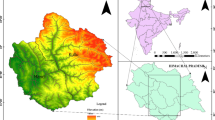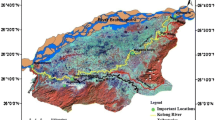Abstract
Water security is a key in achieving sustainable development goals (SDGs); however, it is gradually becoming a scarce resource due to pressure from both climatic and non-climatic factors. Understanding sources and extend of vulnerability of the water resources is the very first step to design appropriate strategies aimed at securing water for various uses. This study therefore assessed vulnerability of water resources and its spatial distribution across the Palikas (new local governments) with Gulmi district in Province-5 as the case study. Vulnerability was assessed using an indicator-based framework comprising of two components and six sub-indices. Results showed that Musikot is the highly vulnerable Palika among the 12 Palikas, and Resunga is the least vulnerable. The results are useful for prioritizing the Palikas for allocating resources aimed at targeting new programs for reducing poverty and conserving natural resources.




Similar content being viewed by others
References
Adger WN, Brooks N, Bentham G, Agnew M, Eriksen S (2005) New indicators of vulnerability and adaptive capacity. Technical Report 7, Tyndall Centre for Climate Change Research
Alcamo J, Moreno JM, Nováky BMB, Corobov R, Devoy R, Giannakopoulos C, Araujo M (2007) Europe. Climate Change 2007: impacts, adaptation and vulnerability: contribution of working group II to the fourth assessment report of the intergovernmental panel on climate change. In: Ipcc Wgii Fourth Assessment Report. Cambridge: Cambridge University Press
Al-Kalbani MS, Price MF, Abahussain A, Ahmed M, O’Higgins T (2014) Vulnerability assessment of environmental and climate change impacts on water resources in Al Jabal Al Akhdar, Sultanate of Oman. Water (Switzerland) 6:3118–3135. https://doi.org/10.3390/w6103118
Al-Sibai M, Droubi A, Al-Ashkar H (2012) Freshwater vulnerability in the Levant region. Int J Clim Chang Strat Manag 4:216–230. https://doi.org/10.1108/17568691211223178
Anandhi A, Kannan N (2018) Vulnerability assessment of water resources—translating a theoretical concept to an operational framework using systems thinking approach in a changing climate: case study in Ogallala Aquifer. J Hydrol 557:460–474. https://doi.org/10.1016/j.jhydrol.2017.11.032
Babel MS, Pandey VP, Rivas AA, Wahid SM (2011) Indicator-based approach for assessing the vulnerability of freshwater resources in the Bagmati River Basin. Nepal Environ Manag 48:1044–1059. https://doi.org/10.1007/s00267-011-9744-y
Cai J, Varis O, Yin H (2017) China’s water resources vulnerability: a spatio-temporal analysis during 2003–2013. J Clean Prod 142:2901–2910. https://doi.org/10.1016/j.jclepro.2016.10.180
CBS (2011) National population and housing census 2011 (National Report). Central Bureau of Statistics. Government of Nepal
Chen Y, Feng Y, Zhang F, Wang L (2019) Assessing water resources vulnerability by using a rough set cloud model: a case study of the Huai River Basin, China. Entropy. https://doi.org/10.3390/e21010014
Chhetri R, Kumar P (2018) Spatial and temporal variability of rainfall distribution in hilly region of Nepal. Int Res J Environ Sci 7:15–21
Chhetri R, Saroj A (2018) The impacts of climate change on water resources in hilly areas of Nepal. I-manager’s. J Future Eng Technol 5:42–49
Chhetri R, Ganguly S, Chand HB, Adhikari S, Raut R, Sharma B (2018) Vulnerability assessment of climate change impacts on water resources at community level in Hilly Areas of Nepal. J Energy Res Environ Technol 5:30–34
DSWASH (2016) District strategic water, Sanitation and Hygiene Plan (Dswashp)
Falkenmark M (1989) The massive water scarcity now threatening Africa, Why isn’t it being addressed? Ambio 112–118
Flörke M, Schneider C, McDonald RI (2018) Water competition between cities and agriculture driven by climate change and urban growth. Nat Sustain 1:51–58. https://doi.org/10.1038/s41893-017-0006-8
Gain AK, Giupponi C, Renaud FG (2012) Climate change adaptation and vulnerability assessment of water resources systems in developing countries: a generalized framework and a feasibility study in Bangladesh. Water (Switzerland) 4:345–366. https://doi.org/10.3390/w4020345
Gawith D, Hill D, Kingston D (2017) Determinants of vulnerability to the hydrological effects of climate change in rural communities: evidence from Nepal. Clim Dev 9:50–65. https://doi.org/10.1080/17565529.2015.1067184
Giordano M, Barron J, Ünver O (2019) Water scarcity and challenges for smallholder agriculture. Sustain Food Agric. https://doi.org/10.1016/b978-0-12-812134-4.00005-4
Gurung A, Adhikari S, Chauhan R, Thakuri S, Nakarmi S, Ghale S, Dongol BS, Rijal D (2019) Water crises in a water-rich country: case studies from rural watersheds of Nepal’s mid-hills. Water Policy. https://doi.org/10.2166/wp.2019.245
Hamouda MA, Nour El-Din MM, Moursy FI (2009) Vulnerability assessment of water resources systems in the Eastern Nile Basin. Water Resour Manag 23:2697–2725. https://doi.org/10.1007/s11269-009-9404-7
Huang Y, Cai M (2009) Methodologies guidelines, Vulnerability assessment of freshwater resources to environmental change. United Nations Environment Programme, United Nations Environment Programme (UNEP) and Peking University, China in collaboration with Mongolian Water Authority and Asian Institute of Technology (AIT), Khlong Nueng
Huq N, Hugé J, Boon E, Gain AK (2015) Climate change impacts in agricultural communities in rural areas of coastal bangladesh: a tale of many stories. Sustainable 7:8438–8460. https://doi.org/10.3390/su7078437
Kale S, Sonmez AY (2020) Trend analysis for streamflow of Devrekani Stream (Turkey). Rev Hydrobiol 12:23–37
Kelly PM, Adger WN (2000) Theory and practice in assessing vulnerability to climate change and facilating adaptation. Clim Change 47:325–352
Kinouchi T, Nakajima T, Mendoza J, Fuchs P, Asaoka Y (2019) Water security in high mountain cities of the Andes under a growing population and climate change: a case study of La Paz and El Alto, Bolivia. Water Secur 6:100025
Komba C, Muchapondwa E (2012) Adaptation to climate change by smallholder farmers in Tanzania adaptation to climate change by smallholder farmers in Tanzania. Econ Res South Afria (ERSA) Work
Koutroulis AG, Papadimitriou LV, Grillakis MG, Tsanis IK, Warren R, Betts RA (2019) Global water availability under high-end climate change: a vulnerability based assessment. Glob Planet Change 175:52–63. https://doi.org/10.1016/j.gloplacha.2019.01.013
Kuchimanchi BR, Nazareth D, Bendapudi R, Awasthi S, D’Souza M (2019) Assessing differential vulnerability of communities in the agrarian context in two districts of Maharashtra, India. Clim Dev. https://doi.org/10.1080/17565529.2019.1593815
Kumar R, Singh RD, Sharma KD (2005) Water resources of India. Curr Sci 89:794–811
Lamastra L, Miglietta PP, Toma P, De Leo F, Massari S (2017) Virtual water trade of agri-food products: evidence from Italian-Chinese relations. Sci Total Environ 599:474–482
Lillesø BJ, Shrestha T, Dhakal L, Nayaju R, Shrestha R (2005) The map of potential vegetation of Nepal the map of potential vegetation of Nepal, Development and Environment, p 110
Magadza CHD (2000) Climate change impacts and human settlements in Africa: prospects for adaptation. Environ Monit Assess 61:193–205
Manandhar S, Pandey VP, Kazama F (2012) Application of water poverty index (WPI) in Nepalese context: a case study of Kali Gandaki River Basin (KGRB). Water Resour Manag 26:89–107. https://doi.org/10.1007/s11269-011-9907-x
Maplecroft (2011) Climate Change Rist Atlas 2010, Vulnerable Nations and Safe Havens [WWW Document]
McPhillips D (2017) 10 Countries with the worst water supply. U. S. News and World Report
Mirza MMQ (2003) Climate change and extreme weather events: can developing countries adapt? Clim Policy 3:233–248. https://doi.org/10.3763/cpol.2003.0330
MOF (2017) Economic survey: fiscal year 2016/17. Singh Durbar, Kathmandu
Mohammed T, Quasem A (2018) Climate change and water resources in Algeria: vulnerability, impact and adaptation strategy. Econ Environ Stud 18:411–429
Moncada AM et al (2020) Modelling water stress vulnerability in small Andean basins: case study of Campoalegre River basin, Colombia. Int J Water Resour Dev 00:1–18
O’Brien K, Leichenko R, Kelkar U, Venema H, Aandahl G, Tompkins H, Javed A, Bhadwal S, Barg S, Nygaard L, West J (2004) Mapping vulnerability to multiple stressors: climate change and globalization in India. Glob Environ Chang 14:303–313. https://doi.org/10.1016/j.gloenvcha.2004.01.001
Pan Z, Jin J, Li C, Ning S, Zhou R (2017) A connection entropy approach to water resources vulnerability analysis in a changing environment. Entropy 19(11):591. https://doi.org/10.3390/e19110591
Pandey VP, Babel MS, Kazama F (2009) Analysis of a Nepalese water resources system: stress, adaptive capacity and vulnerability. Water Sci Technol Water Supply 9:213–222. https://doi.org/10.2166/ws.2009.245
Pandey VP, Babel MS, Shrestha S, Kazama F (2010) Vulnerability of freshwater resources in large and medium Nepalese river basins to environmental change. Water Sci Technol 61:1525–1534. https://doi.org/10.2166/wst.2010.751
Pandey VP, Babel MS, Shrestha S, Kazama F (2011) A framework to assess adaptive capacity of the water resources system in Nepalese river basins. Ecol Indic 11:480–488. https://doi.org/10.1016/j.ecolind.2010.07.003
Pandey VP, Manandhar S, Kazama F (2012) Water poverty situation of medium-sized River Basins in Nepal. Water Resour Manag 26:2475–2489. https://doi.org/10.1007/s11269-012-0027-z
Pandey R, Meena D, Aretano R, Satpathy S, Semeraro T, Kumar Gupta A, Rawat S, Zurlini G (2016) Socio-ecological vulnerability of smallholders due to climate change in mountains: agroforestry as an adaptation measure. Chang Adapt Socio-Ecol Syst 2:26–41. https://doi.org/10.1515/cass-2015-0003
Parry M, Parry ML, Canziani O, Palutikof J, Van der Linden P, Hanson C (2007) Climate change 2007-impacts, adaptation and vulnerability, Working group II contribution to the fourth assessment report of the IPCC, vol 4
Portilla ICB, Sánchez ICH, Tarquino IR (2020) Diffuse cognitive maps for analysis of vulnerability to climate variability in Andean rural micro-watersheds. DYNA 87(212):38–46
Ramprasad V (2018) Debt and vulnerability: indebtedness, institutions and smallholder agriculture in South India. J Peasant Stud 0:1–22. https://doi.org/10.1080/03066150.2018.1460597
Rodell M, Famiglietti JS, Wiese DN, Reager JT, Beaudoing HK, Landerer FW, Lo MH (2018) Emerging trends in global freshwater availability. Nature 557:651–659. https://doi.org/10.1038/s41586-018-0123-1
Rosenberg EA, Keys PW, Booth DB, Hartley D, Burkey J, Steinemann AC, Lettenmaier DP (2010) Precipitation extremes and the impacts of climate change on stormwater infrastructure in Washington State. Clim Change 102:319–349. https://doi.org/10.1007/s10584-010-9847-0
Sánchez Rodríguez RA, Morales Santos AE (2018) Vulnerability assessment to climate variability and climate change in Tijuana, Mexico. Sustainability 10(7):2352. https://doi.org/10.3390/su10072352
Sharma BR, Ambili G (2009) Impact of climate change on water resources and potential adaptations for agriculture in the Indus-Gangetic Basin. In: 5th Asian resignation conference, pp 6–11
Sharma E, Molden D, Rahman A, Khatiwada YR, Zhang L, Singh SP, Yao T, Wester P (2019) The hindu kush himalaya assessment. Springer Int Publ. https://doi.org/10.1007/978-3-319-92288-1
Shrestha RP, Pasakhala B, Qasim S (2019) Assessing household vulnerability to climate variability in far-west Nepal. Nature 12:83–118
Simha P, Mutiara ZZ, Gaganis P (2017) Vulnerability assessment of water resources and adaptive management approach for Lesvos Island, Greece. Sustain Water Resour Manag 3:283–295. https://doi.org/10.1007/s40899-017-0095-6
Stathatou P, Kampragou E, Grigoropoulou H, Assimacopoulos D, Karavitis C, Porto MFA, Gironás J, Vanegas M, Reyna S (2016) Vulnerability of water systems: a comprehensive framework for its assessment and identification of adaptation strategies. Desalin Water Treat 57:2243–2255. https://doi.org/10.1080/19443994.2015.1012341
Tesfaye W, Seifu L (2016) Climate change perception and choice of adaptation strategies. Int J Clim Chang Strat Manag 8:253–270. https://doi.org/10.1108/ijccsm-01-2014-0017
United Nation (2003) Indicators for Monitoring the Millennium Development goals, definitions, rationale, concepts and sources. United Nations Publication, New York
United Nations (2015) Transforming our world, The 2030 agenda for sustainable development. Resolution adopted by the General Assembly on September 25, 2015 [WWW Document]. URL https://sustainabledevelopment.un.org/post2015/transformingourworld
Xinchun C, Mengyang W, Xiangping G, Yalian Z, Yan G, Nan W, Weiguang W (2017) Assessing water scarcity in agricultural production system based on the generalized water resources and water footprint framework. Sci Total Environ 609:587–597
Zhou Y (2016) Vulnerability and adaptation to climate change in North China : the water sector in Tianjin Vulnerability and adaptation to climate change in North China : the water sector in Tianjin. Res Unit Sustain Glob Chang 1–27
Acknowledgements
The author would acknowledge the Forest research Institute (deemed to be) University for supporting this study. The author would also like thankful to Gobinda Paudel, Megha Shrestha, Keshav Tyagi, Rahul Yadav, Sumit Sharma, Saroj adhikari and Rajesh Raut for their concern support and kind cooperation during study period.
Author information
Authors and Affiliations
Corresponding author
Additional information
Publisher's Note
Springer Nature remains neutral with regard to jurisdictional claims in published maps and institutional affiliations.
Rights and permissions
About this article
Cite this article
Chhetri, R., Kumar, P., Pandey, V.P. et al. Vulnerability assessment of water resources in Hilly Region of Nepal. Sustain. Water Resour. Manag. 6, 34 (2020). https://doi.org/10.1007/s40899-020-00391-x
Received:
Accepted:
Published:
DOI: https://doi.org/10.1007/s40899-020-00391-x




